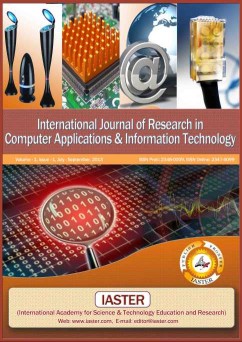ESTIMATE THE SOFTWARE RELIABILITY WITH RECURSIVE GO-MODEL
Keywords:
GO-model, Recursive Technique, Maximum Likelihood Method, Dot Net Platform, MatlabAbstract
The probability that software will work and produce desirable outputs for a specified time under a certain environment is called the reliability of that software. Numerous methods have been designed which can help in improving the reliability of the software which involves intensive and careful planning of testing phase and accurate decision-making. This is done with the use of software reliability analysis model or software reliability growth model. In this article, we are taking into implementation of two such models, namely Goel-Okomoto model and infection S-shaped model and we are comparing and contrasting the results obtained, to come to a conclusion as to which model is better and why. A software reliability model specifies the general form of the dependence of the failure process on the principle factors that affect it: fault introduction, fault removal, and the operational environment i.e. Software reliability modelling is done to estimate the form of the failure rate.
References
K. Y. Cai, D. B. Hu, C. G. Bai, H. Hu, T. Jing, “Does Software Reliability Growth Behavior Follow a Nonhomogeneous Poisson process”, Information and Software Technology, 50,2007, pp. 1232–1247.
T. Nara, M. Nakata, A. Ooishi, “Software Reliability Growth Analysis –Application of NHPP Models and its Evaluation”, Proc. IEEE International ymposium on Software Reliability Engineering, 1995, pp. 251–255.
Wood, “Predicting Software Reliability”, Computer, 1996, pp. 69–77.
T. Keller, N.F. Schneidwind, “Successful Application of Software Reliability Engineering for the NASA Space Shuttle”, Proc. IEEE International Symposium on Software Reliability Engineering (Case Studies), 1997, pp. 71–82.
K.C. Gross, “Software Reliability and System Availability at Sun”, Proc. 11th International Symposium on Software Reliability Engineering, 2000.
Z. Jelinski, and P. B. Moranda, “Software Reliability Research”, Statistical Computer Performance Evaluation (Edited by W. Freiberger), Academic Press, New York, 1972, pp. 465-497.
M. L. Shooman, “Probabilistic Models for Software Reliability Prediction”, Proc. the FaultTolerant Computing Symposium, 1972, pp. 211–215.
E. C. Nelson, “A Statistical Basis for Software Reliability Assessment”, TRW-SS-73-03, 1973.
B. Little wood, J. Verrall, “A Bayesian Reliability Growth Model for Computer Software”, Applied Statistics, 22(3), 1973,pp. 332–346.
J. D. Musa, “A Theory of Software Reliability and Its Applications”, IEEE Transactions on Software Engineering, SE-1, 1975, pp. 312-327.
L. Goel and K. Okumoto, “Time Dependent Error Detection Rate Model for Software Reliability and other Performance Measures”, IEEE Transactions on Reliability, R-28(3), 1979, pp. 206-211.
M. Grottke, and K. S. Trivedi, “On a Method for Mending Time to Failure Distributions”, Proc. International Conference on Dependable System and Network, Los Alamitos, 2005, pp. 560-569.
M. Xie, G. Y. Hong and C. Wohlin, "Software Reliability Prediction Incorporating Information from a Similar Project", Journal of Software and Systems, Vol. 49, No. 1, pp.43-48, 1999.

